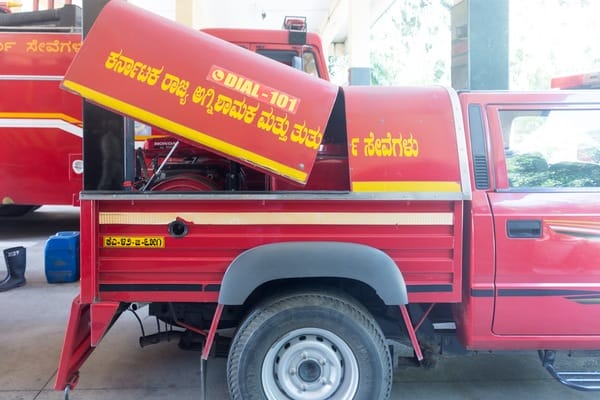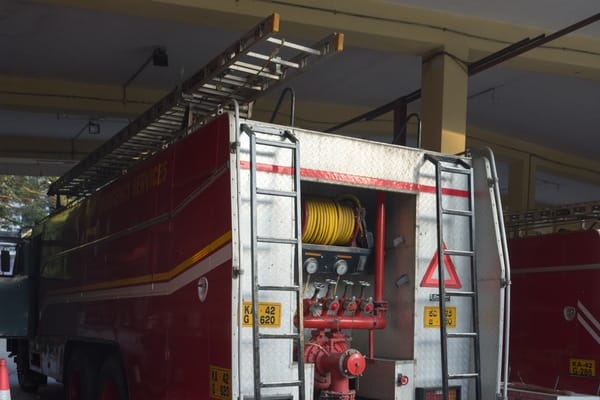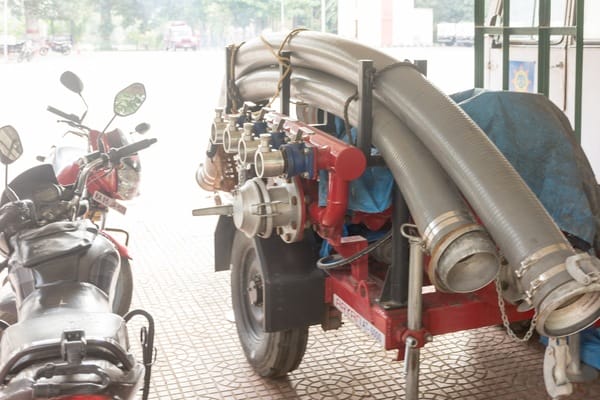Let there be no disasters today. That is the prayer every firefighter begins his day with.
Having said that, they have to be prepared for every emergency, every contingency. Central to their efforts and success is their training, discipline and the equipment at their disposal. Karnataka State Fire and Emergency Services is the agency that handles fire rescue and other disaster management operations in Karnataka. We visited Jayanagar fire station in Bengaluru to understand how the department works.
Among the fire stations in Bengaluru, Jayanagar fire station in Bengaluru South Range is among the largest and busiest. It has a fire training academy adjacent to it, which is ranked as the second best fire training academy in India, right after the one at Nagpur. The Jayanagar fire station has the only service station for all the fire trucks in all of Karnataka.
Watch the video to see some of the tools used in the Fire Department.
A visit to the Jayanagar fire station gives you a fascinating glimpse of the various machines present at the station that are used by the firemen:
QRV (Quick Rescue Vehicle)
This vehicle started out as a Tata 207 pick-up truck, which was subsequently converted to a quick rescue vehicle. The QRV has two tanks: one for foam and the other for water. The water tank fitted to this vehicle has a capacity of 500 litres. The foam tank usually has a capacity to hold 125 litres.

Rear of Quick Response Vehicle (QRV) Pic: Nikhil Reddy
The foam is generated from animal fat and acts as an insulation between the fire and the fuel. The vehicle has an onboard pump. The foam gets mixed with water as it is pumped out from the vehicle, and is thus sprayed. There is, however, no specific ratio of foam to water which is used for the foam to be sprayed.
This vehicle is used for small to medium fires. A classic example where the QRV could be used is a petrol bunk which has caught fire.
MRV/RV (Medium Rescue Vehicle)
This vehicle is used for rescue operations – not primarily for firefighting. It has all the tools needed by firefighters to carry out rescue operations. It has four searchlights mounted on a telescopic pole which can be extended up to 60 metres in the air to aid, search and rescue.
The tools present in the MRV are interesting. There is a tool for every occasion!
- Circular saw: Used in cutting open and rescuing people from cars and collapsed buildings. It has a round circular wheel which is similar to a grinding wheel found at many workshops.
- Hydraulic spreader: This is used to rescue people in trapped elevators. This tool is used to keep the elevator doors from closing shut.
- Hydraulic combi tool: This is used to crush down or crush open the doors of cars which may be involved in an accident.
- 5KVA diesel generator: Used for powering the lights needed in rescue operations conducted at night or in dark places.
- Portable lights and cables: These are used for rescue operations at night.
- Pick axes, shovels: These are used to rescue people from landslides.
- Inflatable rubber boats: These are used to rescue people from flooded areas and lakes.
- Bolt-cutters: These are used to cut open metal doors.
- Lift key: This is a device used to open lift doors in case of an emergency.

This ring attached to the wheel hub of the MRV is used to tow away vehicles/remove obstacles. Pic: Nikhil Reddy
Water bozer
This vehicle is primarily used in firefighting. It is equipped with a tank capable of holding 16,000 litres of water. At the back of this vehicle, there are four different taps connected to a pump which generates a huge amount of pressure. This vehicle has a water cannon on the roof which is used for spraying water across huge distances; this is also used in crowd dispersal during riots. This truck has the capacity to carry 30 fire hoses at any given time.

A closer look at the ladder on the water bozer. Pic: Nikhil Reddy
The Water tender
This is another vehicle which goes out frequently for supporting other fire departments in fire fighting. It has a tank capacity of 4500 litres of water. It looks similar to the water bozer except for the water cannon on the roof.
The Portable Pump
A portable pump (PP) is a device used by firefighters in situations where they need extra water pressure. This is primarily used in places wherein the larger trucks are unable to reach the location of the fire.

This machine is used to pump out stagnant water from subways and underpasses. Pic: Nikhil Reddy
Agni
This vehicle, which started out as a Royal Enfield electra is used for firefighting in places where the road accessibility is very difficult. It has two cylinders: one for foam and the other for water.
Fire Stations in Bengaluru and around:
- South (Field Marshal Kariyappa Road
- M.G.Road, Bengaluru, Karnataka 560025);
- Mahadevapura
- Hosakote (Bengaluru Rural);
- Banashankari
- Jayanagar
- Sarjapura Road
- Anjanapura
- Anekal
- North
- Hebbala
- Highground
- Banaswadi
- Jakkur (Yelahanka)
- Doddaballapura (Bengaluru Rural)
- Peenya
- Nelamangala (Bengaluru Rural)
- Rajajinagar
- Yeshwanthpura
Source: Karnataka State Fire and Emergency Services Department
How does one reach out to Fire Department in case of emergency?
- Call 101, 08022971500, 08022971550. 08022971600
- Tweet to @KarFireDept or @DGP_Fire for issues of less emergency.
- Also read: Fire safety: 25 things to keep in mind
- Read this to figure out Fire safety norms for buildings.
- What problems does the department face in a city like Bengaluru? Read this article to understand it better.
Related Articles
Fire in your building? Call 101 first
City fire safety trapped in smoke
Fire safety: 25 things to keep in mind
No one knows where the fire equipment is
Beyond Carlton launches India’s first fire safety community
New fire safety norms for city high rises
No land for firestations in Bangalore